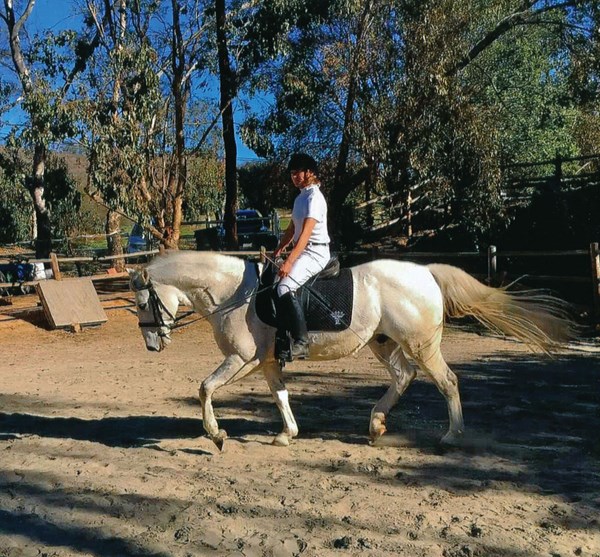
Create Light Contact
This picture shows Hallie Eisenhouer riding the 9-year-old Lipizzan gelding, Pluto Fantasia. The pair is currently working at Training Level. Pluto is a typical Lipizzan, with a compact body, nice, strong neck and powerful hind legs. In this picture, he is stretching nicely forward and downward in the trot while displaying good activity in his hind legs.
Hallie clearly wants to help him stretch and activate his engine at the same time. However, she shows a tendency to sit a bit behind her horse’s movement and keep her hands too low. I often see riders who want to lower their horses’ heads press their own hands down too low. This may, for a moment, be successful as it imitates the function of side reins, but it does not teach the rider or the horse the correct feel for the contact. On the contrary, it more often ends with the horse falling heavier on the forehand. As I look at the photograph more closely, I notice that Hallie is actually not pressing down with her hands, but instead she is merely relaxing her arms—however, the weight of her forearm is making her whole arm drop down too low.
In this picture and in the short video clip (http://bit.ly/1Gp5wlT), I notice that Hallie tries to give Pluto as much rein as possible. Often when encouraging him to stretch, she drops the contact of the reins completely. It is not uncommon to see that when a rider gives a horse more rein, the horse might relax more in his body, but he also might sacrifice some core stability at the same moment.
A consistent contact is necessary for the horse to stretch to the bit. Stretching is work. If I do a stretching workout for myself, I work hard with my body. It is important for Hallie to understand that a supple moving horse with a supple sitting rider requires a lot of strength, which then requires positive tension and core stability.
It might help Hallie to concentrate on what her exact goal is at a particular moment and then ask herself why she feels the need to release the contact. I sometimes verbally ask my riders that exact same question: Why are you giving the contact?
In riding we can use a giving moment in the reins to help establish:
• contact
• balance
• rhythm
• self-carriage
• lightness
• flexion
• attention
• security
• softness
•… the list can be continued.
But note that the rider should never throw away the contact or drop the contact with the horse. If you use a giving moment in the reins, make sure that you are doing it intentionally and with a particular goal in mind.
Consistent contact helps the horse balance between forward-pushing power and carrying power—also known as extension and collection, respectively.
My cousin, Felicitas von Neumann-Cosel, described the concept of ideal contact to me once by using an image of a ballet dancer reaching out for a pole while maintaining a difficult balance pose. Just the dancer’s fingertips on the pole can be enough to stabilize this fragile position. But if the pole is suddenly taken away, the dancer will stumble out of the balanced posture.
This is similar to a horse that is reaching to the contact—a very light contact can improve and secure the horse’s self-carriage and balance, encouraging him to stretch through his topline. But if this contact suddenly disappears, this balance will be disturbed and the picture of harmony and lightness will vanish as if someone put a needle into a balloon. The idea that a light contact should help the horse balance gives a clearer meaning to the word “rein aid.” It is an aid, not a force.
With intention and purpose linked to the idea of light contact, Hallie may find it easier to stay taller in her seat and develop more positive tension. This will make it easier for her nice Lipizzan to stretch into the contact and maintain this position for a longer period and especially during transitions. I hope that this gives Hallie some ideas to focus on in her training to improve steady contact to the bit.











